Rajasthan Board RBSE Class 12 Chemistry Chapter 12 Organic Compounds with Functional Group-Containing Oxygen (Part-2)
RBSE Class 12 Chemistry Chapter 12 Text Book Questions
RBSE Class 12 Chemistry Chapter 12 Multiple Choice Questions
Question 1.
The hybridisation of carbonyl carbon in carbonyl compounds is
(a) sp2 d
(b) sp3
(c) sp2
(d) sp
Question 2.
Which of the following cannot be synthesised by Stephen’s reaction?
(a) CH3CHO
(b) CH3CH2CHO
(c) C6H5CHO
(d) CH3COCH3
Question 3.
Which isomerism is shown by pentanone?
(a) Chain isomerism
(b) Position isomerism
(c) Functional isomerism
(d) All of these
Question 4.
Which of the following is used for the reduction of aldehydes and ketones in Clemmenson’s reduction?
(a) Zinc Amalgam and conc. HCl
(b) Red P and HI
(c) LiAlH4
(d) Sodium ethoxide
Question 5.
The reduction of acetone by Mg-Hg gives:
(a) Aldol
(b) Propane
(c) Pinacol
(d) Propanol
Question 6.
Aldehyde and ketones do not react with
(a) Sodium bisulphide
(b) Phenylhydrazine
(c) Dihydrogen sodium phosphate
(d) Semicarbazide
Question 7.
When ethanol is heated with Fehling’s solution, then the precipitate obtained is of
(a) Cu
(b) CuO
(c) Cu2O
(d) Cu + CuO + Cu2O
Question 8.
Which of the following is not synthesized by Rosenmund reduction:
(a) Formaldehyde
(b) Acetaldehyde
(c) Butyraldehyde
(d) Formaldehyde and acetaldehyde
Question 9.
Which of the following do not undergo aldol condensation?
(a) CH3CH2CHO
(b) C6H5CHO
(c) CH = CCHO
(d) CH2 = C(CI) CHO
Question 10.
Which of the following method is used for conversion of the ketone to hydrocarbon?
(a) Aldo condensation
(b) Wolf-Kishner Reduction
(c) Cannizzaro’s Reaction
(d) Clemmenson Reduction
Answers:
1. (c)
2. (d)
3. (a)
4. (a)
5. (c)
6. (c)
7. (c)
8. (a)
9. (a)
10. (b)
RBSE Class 12 Chemistry Chapter 12 Very Short Answer Type Questions
Question 1.
Write the IUPAC name of
1. Acetaldehyde
2. Isobutyraldehyde
Answer:
1. CH3CHO: Ethanal
2. (CH3 )2CH – COOH: Isobutyraldehyde
Question 2.
Write the IUPAC name of
(a) Methyl propyl ketone
(b) Ethyl methyl ketone
Answer:

Question 3.
What is the significance of Oppenaur oxidation?
Answer:
Secondary alcohol can also be oxidised to ketones by this method.
Question 4.
Why formaldehyde cannot be prepared by Rosenmund reduction.
Answer:
Formaldehyde cannot be prepared by this method because HOCl is unstable at room temperature.
Question 5.
What are the main reactions shows by carbonyl compounds?
Answer:
Carbonyl compounds show the following types of chemical reactions:
- Nucleophilic addition reactions
- Nucleophilic addition-elimination reactions
- Oxidation, reduction and halogenation.
Among them, the nucleophilic addition reaction is the important reactions of carbonyl compounds.
Question 6.
Write the following in decreasing order of nucleophilic addition.
CH3 CHO, CH3 COCH3, HCHO,C2H5, COCH3
Answer:
HCHO > CH3CHO > CH3COCH3 > CH3CH2COCH3.
Question 7.
What is Tollen’s reagent?
Answer:
Ammonical silver nitrate solution is known as Tollen’s reagent.
Question 8.
Write the name of one aldehyde which does not give Fehling’s test.
Answer:
Aromatic aldehydes such as benzaldehyde do not give Fehling’s test.
RBSE Class 12 Chemistry Chapter 12 Short Answer Type Questions
Question 1.
Write the name of the product obtained by ozonolysis of ethene and write equation also.
Answer:
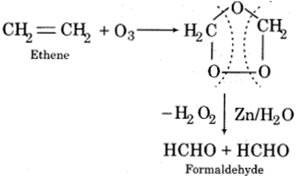
Question 2.
Explain Stephen’s reaction and Rosenmund’s reduction.
Answer:
(i) Stephen’s reaction:
Cyanides are reduced to aldehydes by treating their ethereal solution with stannous chloride and hydrogen chloride gas at room temperature. Imine hydrochloride is initially formed which upon boiling with water gives aldehyde. This reduction is called Stephen’s reaction.
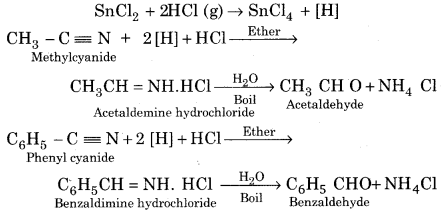
(ii) Rosenmund’s reduction:
Aliphatic as well as’ aromatic aldehydes can be prepared by the reduction of acid chlorides with H2 in the presence of palladium (Pd) deposited over barium sulphate along with a small amount of sulphur or quinoline. This mixture is called Lindlar’s catalyst, Both sulphur and quinoline poison palladium and check its ability to reduce aldehyde into alcohol. This reaction is called Rosenmund’s reduction.

Question 3.
‘Aldehydes are good reducing agents’ explain by giving their reactions.
Answer:
Aldehydes are easily oxidized to carboxylic acids on treatment with common oxidizing agents like HNO3, KMNO4, K2Cr2O7 etc even mild oxidizing agents also. Mainly Tollen’s reagent and Fehling’s reagent also oxidise aldehyde.

Thus aldehydes act as strong reducing agents.
For example:
(i) Aldehyde reduces Tollen’s reagent into metallic silver.

(ii) Aldehydes reduce Fehling’s solution.

(iii) Aldehydes reduce Benedict’s solution.
![]()
Question 4.
Complete the following reactions and write product also.

Answer:

Question 5.
What is Meerwein Ponndrof Verley reduction? Explain.
Answer:
Meerwein – Ponndrof – Verley (MPV) reduction in organic chemistry is the reduction of aldehydes and ketones to their corresponding alcohol utilizing aluminium alkoxide catalyst in the presence of sacrificial alcohol, The beauty of the MPV reduction lies in its high chemoselectivity and its use of a cheap environmentally friendly metal catalyst.

Question 6.
Explain the reason for the acidity of the α – hydrogen atom in the aldehyde.
Answer:
The reason for the unusual acidity of the α – hydrogens in aldehydes are as follows:
(i) The carbonyl group is strongly electron withdrawing and when an aldehyde loss a proton the anion enolate ion is produced is stabilized by delocalization.

Two resonance structures A and B can be written for delocalization of ion. Both structures contribute to the hybrid, Although structure A is favoured by the strength of its carbon-oxygen bond relative to the weaker carbon-carbon bond of B. Structure B makes a greater contribution to the hybrid because oxygen, being electronegative is better able to accommodate the negative charge. We can depict the enolate hybrid in the following way.

When this resonance stabilized enolate accepts a proton it can do so in either of two ways:
- It can accept the proton at the carbon to form the original carbonyl compound which is called the keto form or it may accept the proton at oxygen to form an enol.
- The enolate is the conjugate base of both the enol and keto forms. Both of these reactions are reversible.
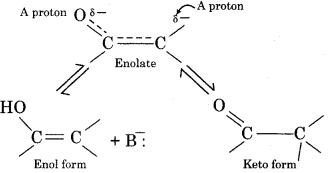
Question 7.
Explain the commercial importance of formaldehyde and acetaldehyde.
Answer:
(i) Formaldehyde:
- 40% solution of formaldehyde (formalin) is used for the preservation of biological specimens.
- To prepare bakelite (a phenol-formaldehyde resin), urea formaldehyde resin and other polymeric products.
- It is used as an insecticide.
- Formaldehyde forms urotropine which is used in medicines. It forms many dyes like indigo, rosaniline etc.
(ii) Acetaldehyde:
- Acetaldehyde is used primarily as a starting material in the manufacture of acetic acid, ethyl acetate, vinyl acetate, polymers and drugs.
- Acetaldehyde is used in the preparation of dyes and resins. It is used for the preparation of aromatic acids.
- It is used in pulverisation of the mirror.
- In the formation of medicine paraldehyde.
Question 8.
Write the method of preparation of pinacol from ketone.
Answer:
When ketone is heated with magnesium amalgam and reduced with water, pinacols are obtained.

Question 9.
The acidity of formic acid is more than acetic acid. Explain.
Answer:
Due to the +I effect of the alkyl group the electron density on the oxygen atom increases and its electron accepting nature in the OH bond decreases accordingly. The release of H+ ion becomes difficult. Thus, greater the magnitude of +I effect weaker will be the acid.
order of +I effect: H > CH3
Therefore, formic acid (HCOOH) is more acidic than acetic acid (CH3COOH).
RBSE Class 12 Chemistry Chapter 12 Long Answer Type Questions
Question 1.
Explain the difference between aldehyde and ketones.
Answer:
Differences between aldehydes and ketones
| S.No | Test | Aldehydes | Ketones |
| 1. | Tollen’s Reagent | Silver mirror is obtained | No reaction |
| 2. | Fehling’s Solution | Red ppt. is obtained | No reaction |
| 3. | Reduction by LiAIH4 | Form primary alcohols | Form secondary alcohols with difficulty |
| 4. | Reaction with alcohol in the presence of dry HCI | Form acetal | Form ketal with difficulty |
| 5. | Schiffs reagent | The pink colour is obtained | No reaction |
| 6. | Reaction with sodium nitro – oxide in the presence of sodium hydroxide | No reaction | Red colour appears |
| 7. | Reaction with m – dinitrobenzene in the presence of sodium hydroxide | No reaction | The red violet colour appears |
| 8. | Reaction with sodium hydroxide | Brown resin is obtained | No reaction |
Question 2.
Which methods are used for the preparation of both aldehydes and ketones? Give the chemical equation for all.
Answer:
(i) Preparation of Aldehyde
1. From the reduction of alkyl nitrile (Stephen Reduction):
When the solution of alkyl nitrile in ether is reduced with stannous chloride in the presence of hydrochloric acid at room temperature then Imine hydrochloride precipitated, which on hydrolysis with hot water gives aldehyde.

This reaction is called Stephen Reduction.
2. From acyl chloride (acid chlorides) by Rosenmund Reduction:
Acid chloride, when reduced with hydrogen in boiling xylene in presence of palladium catalyst (BaSO4 + S or quinolone), gives aldehyde.
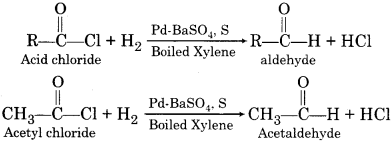
This reaction is called Rosenmund’s reduction. Formaldehyde cannot be prepared by this method because HCOCl is unstable at room temperature. Generally, aldehydes on further reduction give primary alcohols but here BaSO4 and sulphur or quinoline act as catalytic poison for Pd catalyst and prevent the reduction of aldehyde to alcohol.
(ii) Methods for Preparation of Ketones
1. From acid chlorides or Acyl Chlorides:
The ketones are easily prepared by reaction of suitable dialkyl cadmium with acid chlorides.
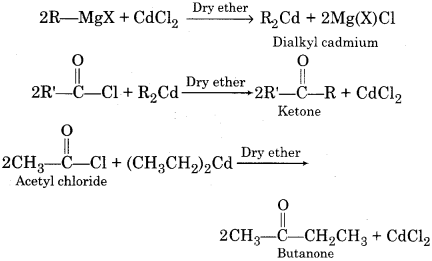
In this reaction, the Grignard reagent cannot be used directly because it is more reactive than dialkyl cadmium and converts the ketone produced in reaction into tertiary alcohols.
2. From Nitriles:
Ketones can be easily prepared by the reaction of the Grignard reagent with suitable alkyl nitrile.
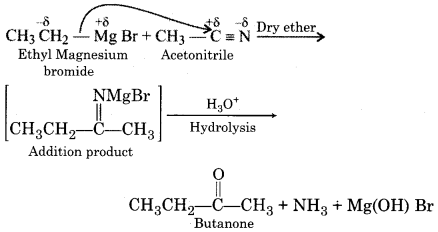
In the above reaction, if hydrocyanic acid is used in place of alkyl nitrile then aldehydes are formed.
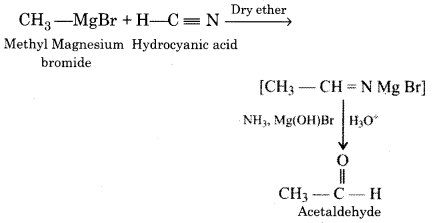
3. From ketonic hydrolysis of Acetoacetic ester or its alkyl derivative:
Acetoacetic ester or its alkyl derivatives are heated in the presence of dilute bases gives ketones after ketonic hydrolysis.
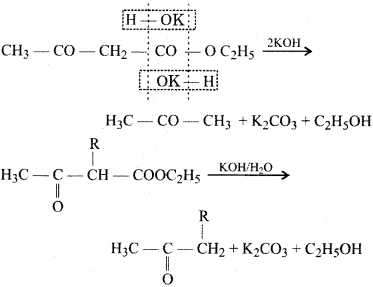
Question 3.
Aldehydes are more reactive towards nucleophilic addition reactions. Explain.
Answer:
Nucleophilic Addition Reaction:
Aldehyde and ketones are unsaturated compounds hence they show nucleophilic addition reactions.
Mechanism of Nucleophilic Addition Reactions:
The reason for the activity of aldehyde and ketone is due to the presence of polar >C=O bond in them. As oxygen is more electronegative hence it attracts electron density towards it therefore partial negative charge develops on it, on the other hand, partial positive charge develops on a carbon atom.

For initiating the reaction a nucleophile attacks positively charged carbon atom and an intermediate is formed which further convert into the product after the attack of H+. A nucleophile attacks the electrophilic carbon atom of the polar carbonyl group from a direction approximately perpendicular to the plane of sp2 hybridised orbitals of a carbon atom.
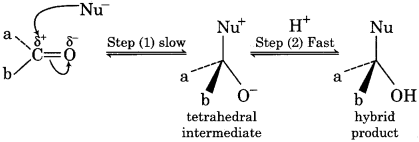
The hybridisation of carbon changes from sp2 to sp3 in this process a tetrahedral alkoxide intermediate is formed. This intermediate capture a proton from the reaction medium to give the electrically neutral product. The net result is the addition of Nu– and H+ across the carbon-oxygen double bond. This reaction is named as nucleophilic addition reaction due to an attack of nucleophile in the slow step of the reaction.
Question 4.
Explain the following reactions and give equations also:
1. Preparation of alcohols from carbonyl compounds
2. Addition product obtained by addition of aldehydes and ketones
3. Reduction of Tollen’s Reagent
4. Baeyer Villiger oxidation
5. Cannizzaro Reaction
6. Kolbe’s Electrolysis
7. Hunsicker Reactions
Answer:
1. Preparation of alcohols from carbonyl compounds – From carbonyl compounds alcohols can be prepared by the following methods:
(a) By the reduction of carbonyl compounds:
The reduction can be carried with either H2 in the presence of Ni or Pt or with LiAlH4 dissolved in anhydrous ether. Aldehydes upon reduction form primary alcohols.
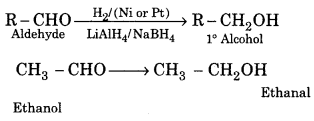
Ketones upon reduction form secondary alcohols
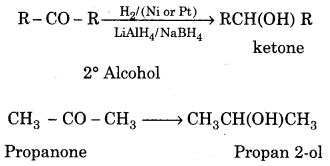
(b) By the action of Grignard reagents on carbonyl compounds:
Aldehydes and ketones combine with Grignard reagents in the presence of anhydrous ether to form addition products which are readily hydrolysed to alcohols. Depending upon the nature of the carbonyl compound different alcohols are formed.

1. Formaldehyde forms primary alcohol.
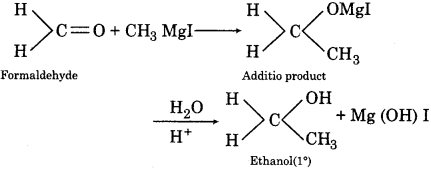
2. All other aldehydes from a secondary alcohol.

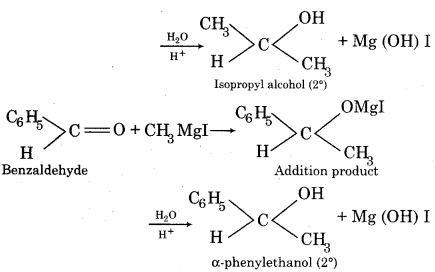
3. Ketones form tertiary alcohol.
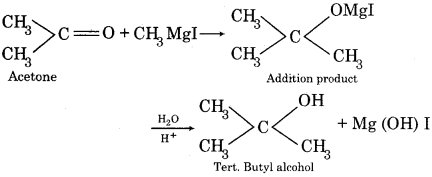
(c) By the reduction of alkyl lithium on carbonyl compounds
Alkyl lithiums are organometallic compounds and are formed by the action of haloalkane with lithium using ether as the solvent.

Alkyl lithium reacts with carbonyl compounds in the same way as Grignard reagents and forms alcohols.
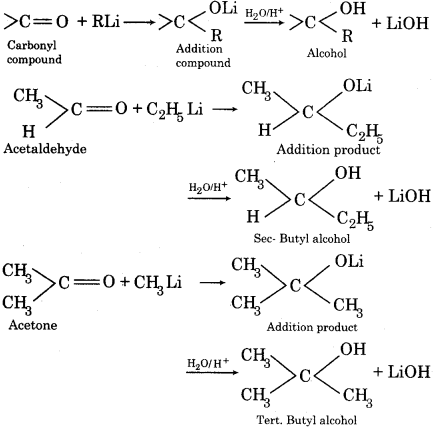
2. Addition products obtained by the addition of aldehydes and ketones:
Aldehydes react with alcohols on passing dry HCl gas to form gem-di alkoxy compounds called acetals.
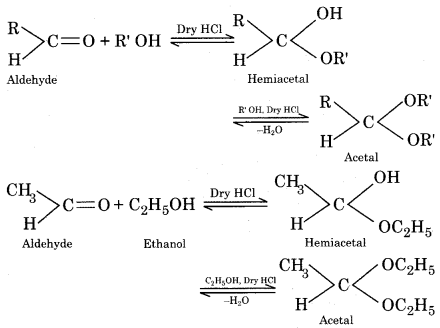
Ketones do not react with monohydric alcohol but form cycle ketals with ethylene glycol as follows:

3. Reduction of Tollen’s Reagent:
Tollen’s reagent is an ammoniacal solution of silver nitrate and is prepared by adding an aqueous solution of NH4OH to that of AgNO3 till the precipitate of AgOH initially formed just redissolves. Upon heating an aldehyde with Tollen’s reagent the latter is reduced to metallic silver which gets deposited on the inner walls of the test tube and shines like a mirror. This reaction is often called the silver mirror test.
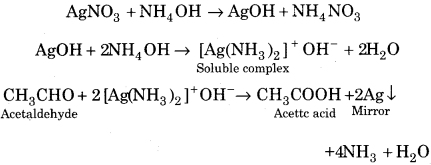
4. Baeyer Villinger oxidation:
In this oxidation reaction, a ketone is reacted with a suitable peracid to form an ester as the product along with carboxylic acid. For example:
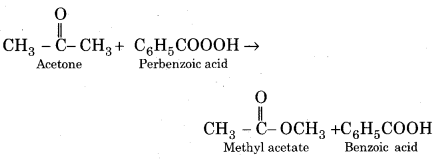
5. Cannizaro’s Reaction:
Aldehydes which have no α – hydrogen atom when heated with NaOH or KOH undergo Cannizaro’s reaction. In this reaction, two molecules of aldehydes undergo self oxidation and reduction to form a mixture of alcohol and salt of carboxylic acid.
For example:
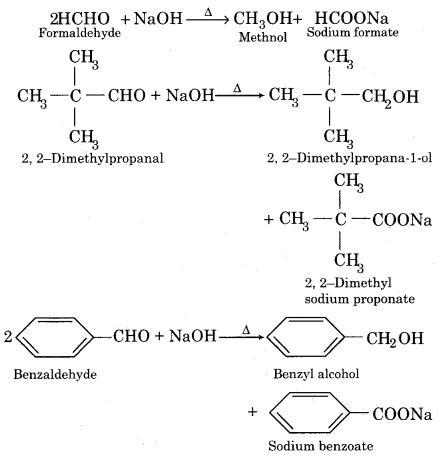
6. Kolbe’s Electrolysis:
The Kolbe’s electrolysis is very useful for the preparation of aliphatic hydrocarbons both saturated (alkanes) and unsaturated (alkanes and alkynes). An aqueous solution of the carboxylic acid is subjected to electrolysis.
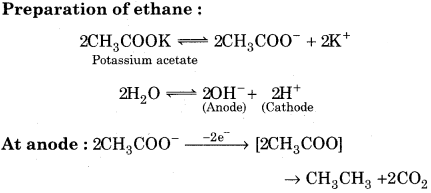
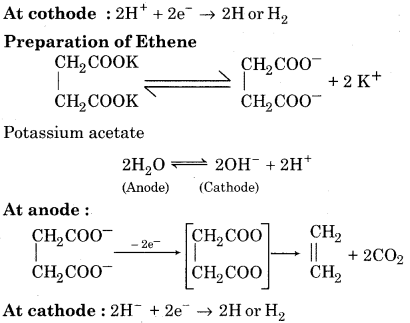
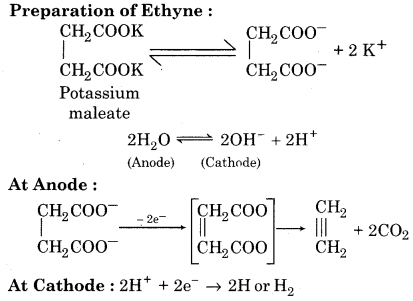
7. Hunsicker Reaction:
The silver salt of a filthy acid can be converted into bromo alkane by refluxing with bromine in the pressure of carbon tetrachloride. This reaction is known as Borodine Hundsdicker reaction or simple Hunsicker reaction.
